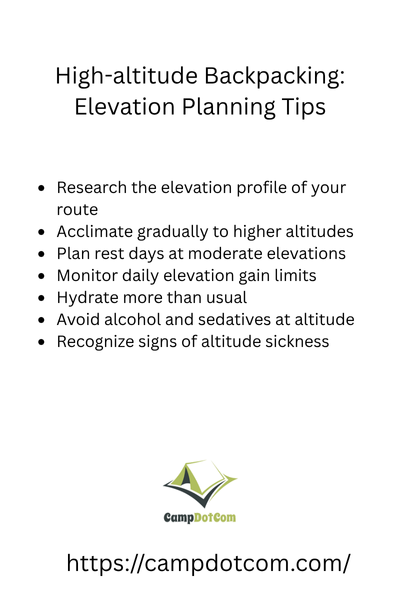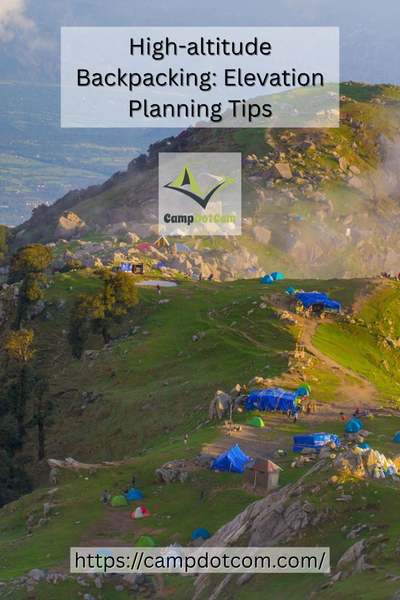High altitude backpacking really is a different kind of challenge, right? It is not just about sore legs and a full pack. You are also up against thinner air, changing weather, and big climbs. But no need to stress. With some good planning for elevation, your trek can be both safer and a lot more fun.
Read More About High-Altitude Backpacking

Why Elevation Planning Matters
Ever climbed a mountain and felt like you suddenly aged 30 years? That’s your body reacting to the altitude. Oxygen levels drop the higher you go, and if you don’t give yourself time to adjust, you could end up battling altitude sickness, exhaustion, or worse.
Planning your elevation gain carefully helps you avoid these nasty surprises and keeps you feeling strong.
As an Amazon Associate, I earn from qualifying purchases. Some of the links in this article are affiliate links. This means that, at zero cost to you, I will earn an affiliate commission if you click through the link and finalize a purchase.
More Things to Know About High-Altitude Backpacking

I learned this the hard way on my first high-altitude backpacking trip. I was so excited to conquer a 12,000-foot peak that I practically sprinted up the first few miles. Big mistake.
The headache hit first, then the nausea, and before I knew it, I was curled up in my sleeping bag feeling like I had the worst flu of my life.
Lesson learned: slow and steady wins the altitude race!
How to Acclimate Properly
The golden rule? Climb high, sleep low. If you’re gaining serious elevation, plan your route so you ascend gradually and sleep at a slightly lower altitude than your highest point of the day. Your body needs time to adjust, and this method helps prevent altitude sickness.
Another trick? Spend a day or two at a moderate elevation before hitting the big climbs. If you’re heading to a 14,000-foot peak, try camping at 8,000–10,000 feet first. It gives your body a head start on acclimatization.
Oh, and hydration! You’ll dehydrate faster at higher altitudes, so drink water constantly—even if you don’t feel thirsty. And yes, that probably means more bathroom breaks, but trust me, it’s worth it.
Understanding Altitude Sickness
Altitude sickness does not care if you run marathons or prefer the couch. It can affect anyone. Mild signs include headaches, feeling dizzy, or a bit queasy.
If it gets worse, it can lead to confusion or trouble breathing, and that is definitely serious.
If something feels off, do not try to push through. Head to a lower elevation and give your body time to bounce back. Some people find medications like acetazolamide helpful, but honestly, going slow is the best approach.
Always remember, no view is worth more than your well being.
Planning Your Daily Elevation Gain
A good rule of thumb is to keep your daily elevation gain under 1,500 feet once you hit 8,000 feet. If you’re backpacking over multiple days, give yourself an easy day after a big climb to help your body adjust. And always have a backup plan in case the altitude hits you harder than expected.
Weather and High Elevations
Another thing about hiking at high elevations is the wild weather. One moment you are soaking up the sun, and the next you are bundled up and bracing for a cold snap. It can switch fast, so always be ready for anything.
Always pack extra layers, and check the forecast before heading out. But even if it looks clear, be prepared for anything.
Lightning is another big concern. Afternoon thunderstorms are common in the mountains, and being the tallest thing on a ridge is not where you want to be.
Plan to hit your highest points early in the day and get below treeline before the storms roll in.
Training for High-Altitude Backpacking
You don’t need to live in the mountains to train for high-altitude backpacking. Building endurance with long hikes and cardio workouts helps, but the real secret? Leg strength and lung capacity.
Steep stair climbs, weighted pack hikes, and interval training will get you in shape for those tough elevation gains.
And if you can, take a few hikes at higher elevations before your big trip. Even if it’s just a weekend getaway to a mountain town, your body will thank you.
Journey Worth Every Step by Planning High Altitude Backpacking
High altitude backpacking is not just about reaching the summit. It is about enjoying the journey and soaking up the adventure along the way. Take your time, enjoy the views, and listen to what your body is telling you.
Planning for elevation might not be as thrilling as choosing gear or plotting your route, but it is the secret to making your trip rewarding instead of exhausting.
Plan wisely, pace yourself, and most of all, enjoy every step you take toward the top.
